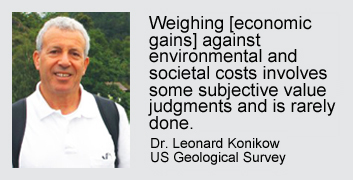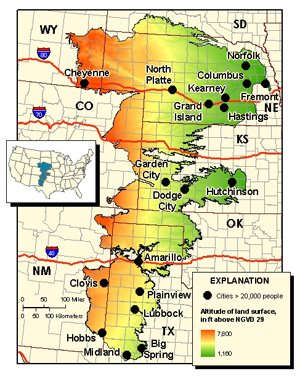An interview with Dr. Leonard Konikow, USGS Research Hydrologist.
The exploitation of groundwater has become increasingly unsustainable, nationally and globally. A report by the US Geological Survey (USGS), ”Groundwater Depletion in the United States,” has grim implications for American agriculture, industry, and drinking water supplies. The study follows equally disturbing reports from NASA’s GRACE program and University of Texas.
The USGS uses the High Plains Aquifer as a case in point:
The depletion during the last 8 years of record (2001–2008, inclusive) is about 32 percent of the cumulative depletion in this aquifer during the entire 20th century. The annual rate of depletion during this recent period averaged about 10.2 cubic kilometers, roughly 2 percent of the volume of water in Lake Erie.
Monika Freyman’s guest post of May 24, presented a detailed discussion of the USGS report. In a subsequent email interview with EarthDesk, Dr. Leonard Konikow, the report’s author, talked about the future of the nation’s, and the planet’s, groundwater.
 EarthDesk: Groundwater is a much larger issue than its individual parts, such as depletion, agriculture, and ocean intrusion in coastal communities. Can you articulate the groundwater issue for us in a holistic way?
EarthDesk: Groundwater is a much larger issue than its individual parts, such as depletion, agriculture, and ocean intrusion in coastal communities. Can you articulate the groundwater issue for us in a holistic way?
Konikow: Groundwater should be viewed as an integral part of the Earth’s hydrologic cycle. This indicates that all water is interconnected, including water in the atmosphere, on the land surface (streams, lakes, oceans, reservoirs, glaciers, etc.), and below the surface of the ground (soil moisture, groundwater, permafrost). Any new stress on one component will ultimately have some effect on all other elements or components of the hydrologic cycle. Each element or component in the cycle can be viewed from two perspectives: as a pathway for water fluxes and as a store (or reservoir) for a mass or volume of water. The atmosphere is a relatively fast pathway with a relatively small storage capacity. But in contrast, aquifers represent a relatively slow pathway for groundwater but with a very large storage capacity. In my recent study, I characterized the total long-term cumulative net depletion of groundwater in the U.S. But that only represents perhaps 10 to 20% of the total pumpage during that same time period. The rest is balanced by capture, which would include reductions in streamflow, drying out of wetlands, and seawater intrusion in coastal areas. These are some of the “unintended consequences.”
EarthDesk: What is the stark reality, short, mid and long-term, for farmlands that are dependent on the Ogallala/High Plains aquifer?
Konikow: In semi-arid to arid climatic regions where groundwater depletion is large, such as most of the Ogallala (High Plains) aquifer, the development and use of groundwater for irrigation of crops is simply not sustainable. I have heard reports that in parts of the Texas and Kansas High Plains, some farmers have already been impacted by increased costs of pumping water from greater depths, and have consequently stopped irrigating. With time, the number of farmers facing such constraints will increase. This problem will be manifested more frequently over larger areas over the next several years to several decades. The problem is much less severe (or absent) in the northern part of the High Plains, and Nebraska’s groundwater use seems sustainable over many decades or longer.
EarthDesk: Given the geologic timescale of the groundwater cycle, are we past the point of no return?
Konikow: There are certainly many areas in the U.S. where the depletion of the past 50 years or so would take many centuries to reverse. But steps can be taken to minimize future declines or perhaps even to begin to reverse past declines. This would require a strong commitment and innovative steps by water managers and politicians. One approach is to reduce demand. For example, Las Vegas and some other areas in arid climates have had success in persuading homeowners to replace their lawns with desert landscaping. Some farmers have switched from water-intensive flood-irrigation methods to more efficient sprinkler or trickle irrigation methods. The second approach is to increase supply. One way to accomplish this is through artificial recharge (also called Managed Aquifer Recharge) in which excess water available during wet periods is injected or allowed to infiltrate into aquifers.
EarthDesk: Your report says that groundwater practices can also account for some degree of sea-level rise.
Konikow: This statement is based on the assumption that eventually most depleted groundwater will end up in the oceans. During 2000-2008, the reported rate of sea-level rise is about 3.1 mm/yr. Thus, during this 8-year period, sea-level rose about 24.8 mm. During this same period, groundwater depletion in the U.S. was about 191 km3. If this volume were spread over the surface area of the oceans, it would produce a sea-level rise of about 0.53 mm, or about 2.1% of the observed sea-level rise.
EarthDesk: Sometimes research reads like an obituary, a fascinating reflection from which the deceased would have benefited while still alive. Is this the case with groundwater, or did we see the coming crisis?
 Konikow: Many people did foresee the “crisis” decades ago. The basic hydrologic principles have been well understood for many decades. What went wrong? Some might argue that nothing went “wrong,” but environmental values and awareness has only broadly increased among the public in relatively recent years (and environmental values have shifted). Certainly the situation regarding groundwater depletion can also be viewed from an economic perspective (as economics has been a major driving force), and recognize that the depleted reserves have also produced (in general) much economic gain. Weighing that against environmental and societal costs involves some subjective value judgments and is rarely done (but probably should be done more often and more carefully and more transparently). Regardless, water use and water management decisions should be made in light of a knowledge of the long-term consequences and impacts on the life of the resource. In areas where groundwater depletion is large, present well yields are simply not sustainable.
Konikow: Many people did foresee the “crisis” decades ago. The basic hydrologic principles have been well understood for many decades. What went wrong? Some might argue that nothing went “wrong,” but environmental values and awareness has only broadly increased among the public in relatively recent years (and environmental values have shifted). Certainly the situation regarding groundwater depletion can also be viewed from an economic perspective (as economics has been a major driving force), and recognize that the depleted reserves have also produced (in general) much economic gain. Weighing that against environmental and societal costs involves some subjective value judgments and is rarely done (but probably should be done more often and more carefully and more transparently). Regardless, water use and water management decisions should be made in light of a knowledge of the long-term consequences and impacts on the life of the resource. In areas where groundwater depletion is large, present well yields are simply not sustainable.
EarthDesk: From a resource management point of view, what could be done differently?
Konikow: One relevant issue here is that laws governing water management and water use vary greatly from state to state, as do hydrologic conditions. Thus, it is difficult to develop and/or impose a consistent national policy. Changing water laws to be more consistent with the scientific understanding of the hydrologic cycle, and to allow more optimal water management, is very difficult to do (though sometimes it has been done). But certainly better education of the public (stakeholders and regulators) as to the state of the science can’t hurt.
EarthDesk: There is great hope placed in groundwater-based irrigation for food production in other parts of the world. Are there issues they should consider, that we have failed to consider in the US?
Konikow: Groundwater depletion and overexploitation is a problem in many parts of the world. But it is not as well documented or understood in most of these areas. One problem is that in most countries, hydrologic conditions are not adequately monitored and data needed to assess the groundwater resource are not available, and where data are collected, are often not made readily available to scientists. The U.S. is perhaps the most open with making relevant data available to scientists, water managers, and to the public, and we have benefited from this “public domain” policy. In some countries, the costs of pumping groundwater from a well is partly to fully subsidized by the government. While this benefits individual farmers, reduces hunger, and helps the economy, it also eliminates any economic incentive for these farmers to conserve water because there is no cost to using it. My answers to your first question apply in the rest of the world just as much as they apply in the U.S.
ADDITIONAL LINKS:
US Environmental Protection Agency Groundwater site
Groundwater and Drinking Water – USEPA
Groundwater FAQ – National Groundwater Association
Private Groundwater Wells – Centers for Disease Control
Groundwater Resources and Irrigated Agriculture — Global Water Partnership










